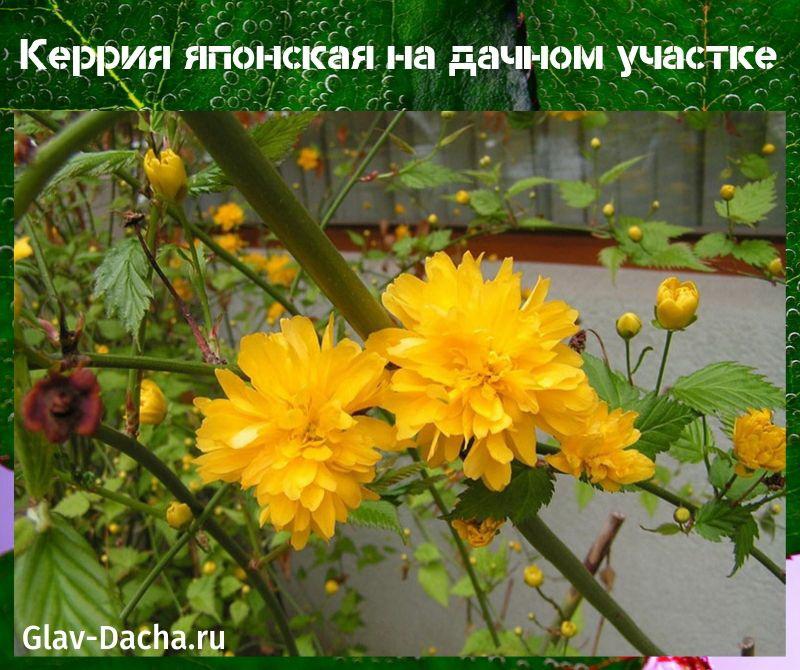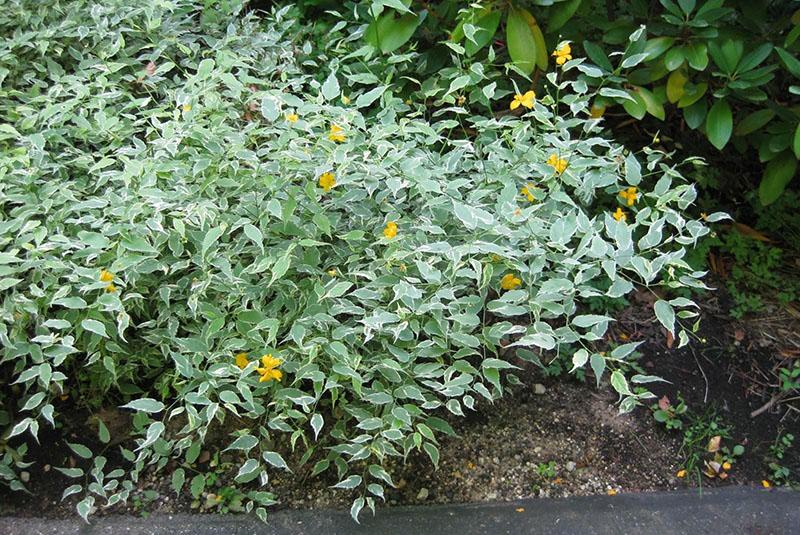Kerria Japanese at their summer cottage
 An ornamental deciduous shrub that blooms in spring with beautiful yellow flowers is keria or Japanese kerria (lat.Kerria). His homeland is considered the highlands of China and Japan. In natural conditions, the bush grows up to 4 m in height, in the summer cottages of Russian gardeners it reaches a maximum height of no more than 2 m.Its name Kerria got in honor of the famous botanist who is engaged in the cultivation of ornamental shrubs in the Ceylon Royal Botanic Garden, researcher and breeder William Kerr.
An ornamental deciduous shrub that blooms in spring with beautiful yellow flowers is keria or Japanese kerria (lat.Kerria). His homeland is considered the highlands of China and Japan. In natural conditions, the bush grows up to 4 m in height, in the summer cottages of Russian gardeners it reaches a maximum height of no more than 2 m.Its name Kerria got in honor of the famous botanist who is engaged in the cultivation of ornamental shrubs in the Ceylon Royal Botanic Garden, researcher and breeder William Kerr.
In landscape design, only one type of plant is used - Japanese kerria. However, the shrub has several popular varieties that differ in the shape of the leaves and flowers.
Description of the appearance of the Japanese kerria

The decorative culture does not lose its attractiveness even after flowering. In summer, the leaves, up to 10 cm long, retain their green color. By autumn they turn bright yellow. Depending on the variety, the buds are simple, double and full. The size of flowers varies from 2.5 to 4.5 cm. Flowering occurs in late May and continues until early August.
If the weather is warm in September and October, the kerria blooms again.
Main characteristics:
| Name | Description |
| Species name | Kerria; |
| Flowering duration | from 40 to 55 days; |
| Planting time of young stock | April, September; |
| Drought tolerance | medium, requires systematic watering during budding and flowering; |
| Frost resistance | medium, requires shelter for the winter; |
| Disease and pest resistance | high, insecticide treatments are not required; |
| Growing features | sanitary pruning of shoots in early spring is necessary, forming pruning after flowering; |
| Reproduction methods | cuttings, dividing the bush, layering. |
Garden designers recommend taking into account the fragility of young shoots when choosing a place for planting a plant.
 If the branches are long, they can break when the wind blows. Therefore, it is advisable to plant nearby shrubs of other species, which will serve as a natural shield.
If the branches are long, they can break when the wind blows. Therefore, it is advisable to plant nearby shrubs of other species, which will serve as a natural shield.
Landing in open ground
 According to gardeners' reviews, Japanese kerria, planting and care (photo below), which are carried out in accordance with agricultural technology, pleases with flowering every year, has a long growing season and an attractive appearance.
According to gardeners' reviews, Japanese kerria, planting and care (photo below), which are carried out in accordance with agricultural technology, pleases with flowering every year, has a long growing season and an attractive appearance.
Recommended conditions for planting:
- in regions with a warm climate, it is advisable to plant seedlings with a developed root system in September, so that the plant has time to take root a month and a half before the onset of cold weather;
- in regions with a short summer, the shrub is recommended to be planted in the spring;
- a suitable place should be well lit, away from groundwater and drafts;
- a planting pit 60/60 cm in size is filled 5 cm with crushed stone or expanded clay to ensure drainage, after which a bucket of fertile mixture is poured into it (humus, sand, dry mineral fertilizers);
- a bucket of water is poured onto the fertile layer, the root system of the seedling is placed on top;
- having straightened the roots, a mixture of turf soil and humus is poured into the pit so that the root collar is at ground level;
- the soil around the trunk is compacted and watered.
Shrubs of the species Kerria are afraid of closely lying groundwater. If the water leaves the roots poorly, they begin to rot and the plant dies. However, the drainage layer helps to cope with this problem; it is not advisable to neglect it when planting.
Necessary care
 A plant with monochromatic leaves is less whimsical to growing conditions than variegated forms. Half of the success of cultivation depends on the correctly chosen planting site: the bush will not bloom in the shade, the flowers will quickly fall off in the hot sun. The best option is partial shade from a tall tree.
A plant with monochromatic leaves is less whimsical to growing conditions than variegated forms. Half of the success of cultivation depends on the correctly chosen planting site: the bush will not bloom in the shade, the flowers will quickly fall off in the hot sun. The best option is partial shade from a tall tree.
 Watering. Moderate, after complete drying of the soil. It is undesirable to overmoisten the soil. From May to August, one watering per week is sufficient.
Watering. Moderate, after complete drying of the soil. It is undesirable to overmoisten the soil. From May to August, one watering per week is sufficient.
Fertilization. After flowering, organic fertilizing is applied (mullein infusion).
Disease prevention. The shrub does not need treatment from viruses and fungi.
 Pruning. In the spring, after swelling of the buds with pruning shears, frozen and broken branches are removed. In an adult plant, all shoots are also shortened by a third, giving shape. After the end of flowering, branches are removed at the root, older than 4 - 5 years, the shoots are shortened to the desired length.
Pruning. In the spring, after swelling of the buds with pruning shears, frozen and broken branches are removed. In an adult plant, all shoots are also shortened by a third, giving shape. After the end of flowering, branches are removed at the root, older than 4 - 5 years, the shoots are shortened to the desired length.
Wintering. Fallen leaves are removed from under the bush, the soil is dug up. Before the first frosts, the branches are tied, laid on the ground and pinned. Cover with fallen leaves, sawdust or spruce branches from above. If severe frosts are expected in the region, then it is advisable to cover the bushes from above with burlap or special covering material, and strengthen them with metal brackets to the ground. Kerria is opened gradually in spring, when the probability of night frosts is minimal.
Types and varieties
One type of Japanese kerria has several varieties. The most popular among them are the following:
- Albomarginata is distinguished by a white outline along the edge of carved leaves, grows slowly, flowers are simple, five-petal.

- Kerria Japanese "Variegata" is notable for its short stature (60 - 70 cm), blooms with simple, yellow flowers.

- Argenteo-marginata has beautiful full flowers and grows up to 2 m in height.

- Albiflora blooms with white medium-sized flowers.

- Aureovariyegata is most loved by flower growers because of its beautiful, full inflorescences and long flowering.

- Pleniflora has small peony flowers and solid green leaves.

Kerria Japanese in landscape design
 Low-growing decorative deciduous shrubs are most effectively combined with kerry.
Low-growing decorative deciduous shrubs are most effectively combined with kerry.  For instance, spirea, Chinese tea, vesicle.
For instance, spirea, Chinese tea, vesicle.  Purple irises, blue phloxes, pink tulips, as well as conifers look smart next door.
Purple irises, blue phloxes, pink tulips, as well as conifers look smart next door.